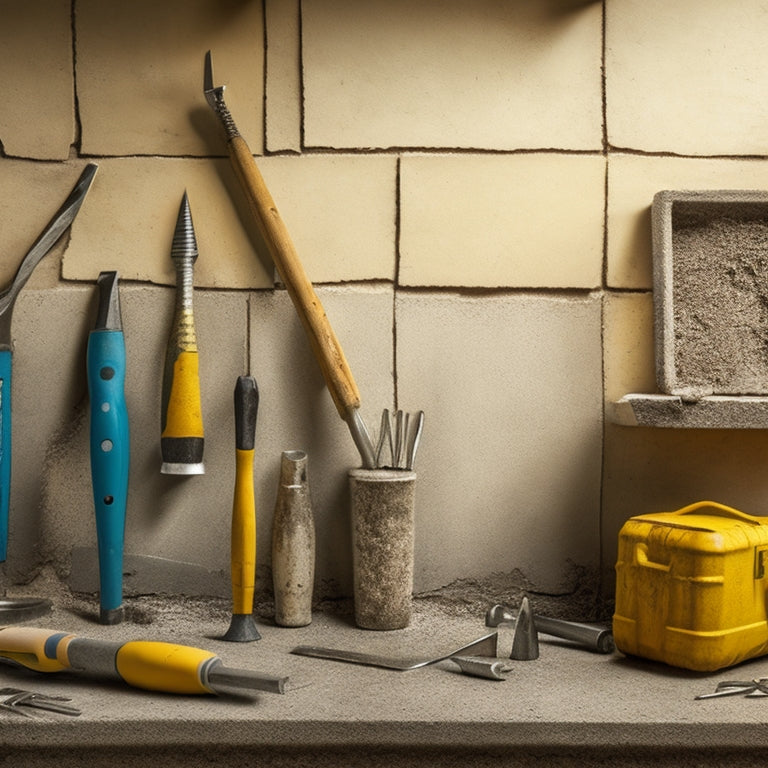
Why You Need Specialized Tools for Concrete Walls
Share
When tackling a concrete wall project, you need specialized tools to guarantee precise and efficient finishing processes, reduce the risk of damage to the surface, and avoid safety hazards. Using the wrong tools or techniques can lead to subpar results, wasted time, and even accidents. For instance, selecting the right drill bits, blades, and grinders is vital for concrete drilling, cinder block cutting, and smoothing rough surfaces. By investing in high-quality, task-specific tools, you'll achieve better results, improve project efficiency, and enhance overall appearance. To reveal the full potential of your concrete wall project, it is important to understand the nuances of each process.
Key Takeaways
- Specialized tools ensure precise and efficient finishing processes, reducing the risk of damage to the concrete surface.
- Proper tools are crucial for achieving a strong bond between concrete and finishes, and for maintaining a smooth finish.
- Using the right tools prevents accidents and waste, as well as promotes a professional-grade finish.
- Specialized tools provide enhanced control, leading to better results and improved overall project efficiency and effectiveness.
- Investing in high-quality, specialized tools pays off through improved project outcomes and a longer tool lifespan.
Concrete Wall Drilling Essentials
How do you guarantee that your concrete wall drilling project gets off to a strong start? It all begins with a solid understanding of drilling techniques and tool maintenance.
You must select the right drill bits and equipment for the job, taking into account the type of concrete, its density, and the desired hole size. Proper tool maintenance is also essential, as a dull or worn-out bit can lead to reduced efficiency, increased wear on the drill, and even safety hazards.
Regularly inspect and clean your drill bits to prevent rust and corrosion. Sharpen or replace them as needed to maintain peak performance. Additionally, make certain your drill is properly calibrated and maintained to provide the necessary power and control.
By mastering drilling techniques, such as applying the right amount of pressure and using the correct drilling angle, you'll be able to efficiently and effectively penetrate even the toughest concrete walls.
With the right tools and techniques, you'll be well on your way to a successful project.
Effective Cinder Block Cutting
When cutting cinder blocks, you'll achieve professional results by mastering effective techniques that minimize waste and prevent damage.
Your blade selection is critical, as the right tool will efficiently cut through the block's aggregate and mortar.
Before you start cutting, make sure you're taking necessary safety precautions to protect yourself from flying debris and dust.
Cutting Techniques Matter
Cutting into a cinder block wall requires finesse and the right techniques to avoid damaging the surrounding structure or the block itself. You need to approach this task with precision and control to achieve a clean, accurate cut.
To master the art of cutting cinder block walls, you must focus on the following key techniques:
-
Optimize your cutting depth: Avoid cutting too deeply, as this can cause the block to shatter or the surrounding structure to weaken. Instead, make multiple shallow cuts, gradually increasing the depth as needed.
-
Control your blade speed: A slow, steady blade speed helps maintain a consistent cut and prevents overheating, which can damage the blade or the block.
-
Use a steady, consistent motion: Apply gentle to moderate pressure, moving the blade in a smooth, continuous motion. This helps prevent kickback and guarantees a straight cut.
- Monitor your progress: Regularly inspect your cut to verify it's accurate and even. Make adjustments as needed to maintain a clean, precise cut.
Blade Selection Crucial
You've mastered the cutting techniques, now it's time to focus on the tool that makes it all possible: the blade. When it comes to effective cinder block cutting, blade selection is vital. You need a blade that can efficiently cut through the concrete without compromising its structure or integrity.
There are various blade types to choose from, each designed for specific cutting applications. For instance, diamond blades are ideal for cutting through hard, abrasive materials like concrete, while abrasion blades are better suited for softer materials like brick.
When selecting a blade, consider the cutting depth required for your project. A blade with a deeper cutting depth will allow you to make more precise cuts, but it may also increase the risk of kickback. You'll need to strike a balance between cutting depth and safety.
Additionally, consider the blade's material, size, and arbor configuration to guarantee it's compatible with your saw or grinder. By choosing the right blade for your concrete cutting needs, you'll achieve professional-grade results with precision and power.
Safety Precautions First
Concrete cutting poses significant safety risks, and it's crucial to prioritize caution before commencing any project.
You're about to work with powerful tools and abrasive materials, which can lead to serious injuries if you're not properly prepared.
Before you start cutting, make sure you've taken the necessary safety precautions:
-
Wear protective gear: gloves, safety glasses, earplugs, and a dust mask to prevent exposure to hazardous materials.
-
Clear the work area: remove any obstacles, flammable materials, or tripping hazards to guarantee a safe and efficient work environment.
-
Check your equipment: confirm your tools are in good condition, and all safety features are functional.
- Plan your cuts: carefully plan your cutting sequence to avoid accidents and minimize waste.
Smoothing Rough Surfaces Quickly
Rough surfaces on concrete walls can be a major obstacle to achieving a smooth, even finish. You need to address these imperfections before applying finishes or coatings. Surface preparation is critical to guarantee a strong bond between the concrete and the finish.
To smooth rough surfaces quickly, you'll need specialized tools designed for concrete walls. Start by using a concrete scrubber or a wire brush to remove dirt, grime, and loose particles.
Next, switch to a concrete grinder or a scarifier to remove thicker imperfections and texture the surface. These tools will help you achieve a more even surface, enhancing the texture and preparing it for finishing.
For more aggressive texture enhancement, consider using a shot blaster or a concrete planer. These powerful tools can quickly remove thick layers of material, leaving a smooth surface.
Remember to always work in small sections, and vacuum or sweep the area clean to prevent dust and debris from accumulating. By using the right tools for surface preparation and texture enhancement, you'll achieve a smooth, even finish that's ready for finishing.
Power Tools for Joint Repair
Now that you've achieved a smooth surface, it's time to focus on joint repair. This critical step guarantees the structural integrity of your concrete wall.
You'll need the right power tools to get the job done efficiently and effectively.
For joint repair, you'll require:
- Joint cleaning tools, such as wire brushes or rotary tools, to remove dirt and debris from the joint.
- Grinders to prepare the joint surface for sealing.
- Pneumatic or electric tools to inject repair materials into the joint.
- Sealant guns to apply the chosen sealant material.
When selecting repair material options, consider factors like flexibility, adhesion, and durability.
You may opt for polyurethane, epoxy, or silicone-based sealants, depending on the joint's specific requirements.
Mastering joint sealing techniques takes practice, but with the right power tools and materials, you'll be well on your way to achieving professional-grade results.
Efficient Block Chiseling Methods
Block-by-block demolition requires efficient chiseling methods to dismantle concrete walls without compromising their structural integrity. You need to master block chiseling techniques that allow you to remove concrete blocks quickly and safely. A vital aspect of efficient chiseling is maintaining your tools. Regular chiseling tool maintenance guarantees that your tools remain in top condition, reducing the risk of damage or injury.
| Chiseling Technique | Maintenance Requirement |
|---|---|
| Hammer and chisel | Regularly sharpen chisel edges and replace worn-out handles |
| Pneumatic chisel | Clean and lubricate air hoses, inspect for worn-out seals |
| Hydraulic chisel | Check and maintain hydraulic fluid levels, inspect for leaks |
When selecting a chiseling technique, consider the type of concrete, block size, and the desired level of precision. By combining the right technique with proper tool maintenance, you'll be able to dismantle concrete walls efficiently and effectively. Remember, efficient block chiseling methods are vital for completing projects on time and within budget.
Finishing Touches for Perfection
With the concrete wall demolition complete, you're left with a rough, fragmented surface that requires attention to detail to achieve a smooth finish.
To take your concrete wall project to the next level, you need to focus on the finishing touches that will elevate its texture and aesthetic appeal.
These vital steps will enhance the overall appearance of your concrete wall:
-
Grinding: Use a specialized grinder to remove any remaining imperfections and create a uniform surface.
-
Polishing: Apply a polishing compound to bring out the natural beauty of the concrete, achieving a high-gloss finish.
-
Sealing: Apply a concrete sealer to protect the surface from stains and damage, ensuring a long-lasting finish.
- Detailing: Add aesthetic details such as joint filling, crack repair, and texture enhancement to create a visually stunning concrete wall.
Frequently Asked Questions
Can I Use Standard Drill Bits for Concrete Wall Drilling?
You can't use standard drill bits for concrete wall drilling; they'll dull or break quickly. Instead, opt for carbide-tipped or diamond-coated bits designed for concrete wall techniques, ensuring efficient drilling and minimizing wear on your equipment.
How Do I Prevent Damage to Surrounding Surfaces During Cutting?
As you begin cutting through concrete, coincidentally, you're also safeguarding adjacent surfaces; employ controlled cutting techniques and install protective barriers to prevent damage, ensuring a precise, powerful cut that yields desired results.
Are Specialized Tools Required for Small Concrete Repair Projects?
When tackling small concrete repair projects, you'll find that specialized equipment is often necessary to achieve professional results, as it enables you to master advanced repair techniques and guarantee a strong, long-lasting fix.
Can I Use a Hammer and Chisel for Large-Scale Block Removal?
When tackling large-scale block removal, you'll find a hammer and chisel ineffective, as they're better suited for small-scale demolition; instead, adopt advanced block removal techniques that utilize powerful, specialized tools for efficient and safe concrete demolition.
Do I Need to Seal Concrete Walls After Repairs Are Completed?
You'll need to apply a suitable sealant, like epoxy or polyurethane, to concrete walls after repairs, depending on the repair method used, to guarantee a strong bond and prevent future damage or water infiltration.
Conclusion
You've learned the importance of specialized tools for concrete walls, from drilling essentials to finishing touches. Now, consider this: the American Concrete Institute estimates that the global concrete industry will reach $642 billion by 2027. This staggering figure underscores the significance of precise and efficient concrete work. With the right tools and techniques, you'll be well-equipped to tackle complex projects and capitalize on this growing market.
Related Posts
-

What Tools Do I Need for Concrete Wall Repair
As you prepare for a concrete wall repair job, you'll need a variety of tools to guarantee a successful outcome. Star...
-

10 Best Tools for Sealed Concrete Flooring on Budget
When starting on a sealed concrete flooring project on a budget, you'll need to prioritize essential tools without sa...
-

Top Tools for Concrete Repair Success
When it comes to concrete repair success, you'll need a well-stocked toolkit with essential hand tools like trowels, ...


